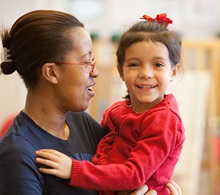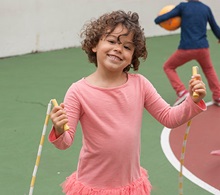
COVID-19 has parents across the country wondering what the upcoming school year will look like for their children. Locally, many preschool and pre-kindergarten programs have been canceled due to the pandemic. This includes the Omaha Public Schools Foundation Parent-Pay Pre-K Program.
These closings are unfortunate because young children who do not attend a Pre-K program are missing out on the many benefits they offer. Research has shown that Pre-K is an especially important year because it provides children with their initial exposure to school and can set the tone for their educational journey. In other words, these programs get kids off on the right foot.
A report from some of the nation’s top early child education researchers, “The Current State of Scientific Knowledge on Pre-kindergarten Effects,” concludes that kids who attend Pre-K programs are better prepared for kindergarten than those who do not. According to the report, the best programs include instruction built on social and emotional skills, rich play, toys, games, art, music and movement. These complement explicit instruction focused on things like learning to count and matching letters to sounds and words.
Attending a Pre-K program offers children much more than an introduction to academics, however. Successful Pre-K programs teach children how to learn to learn, how to be curious about how things work, and how to find answers to problems. These programs also focus on things like self-control and behavior in the class, how to wait your turn, how to share, how to deal with frustration, and how to solve conflicts.
Many people believe that preschool and Pre-K programs are the same thing but this is not the case. Instead, Pre-K is a bridge between preschool and kindergarten. During the early preschool years, children develop vocabulary and language skills. By the time they reach the pre-kindergarten classroom, they continue to work on these skills but they also are gaining the confidence to work independently and complete more in-depth projects with their peers.
In Pre-K programs, everything students do takes on a richer quality because they are starting to do more abstract thinking. They are finding solutions to problems and taking leadership roles in the classroom. Pre-K programs prepare children academically for later school success by diving into the skills that they will use in kindergarten.
At Premier Academy, our Pre-K program will help your child get a head start on formal school. We have small class sizes, play-based learning, a handwriting curriculum, and much more. To learn more about our affordable Pre-K options in the Omaha and Elkhorn area, visit us at premieracademyinc.com.


 If you are the parent of a shy or introverted child you may worry that your son or daughter may not be able to make friends since he or she is uncomfortable in social situations. It is important to realize that there is nothing wrong with shy children, they simply have a different temperament. While you can’t make a child
If you are the parent of a shy or introverted child you may worry that your son or daughter may not be able to make friends since he or she is uncomfortable in social situations. It is important to realize that there is nothing wrong with shy children, they simply have a different temperament. While you can’t make a child  Some of the best memories your child will make are running around, playing outdoors at Preschool, and being active in the amazing summer weather. However, all this running and physical activity in the heat of the day can put children, and adults, at risk for heat stroke, dehydration, harsh sunburns and other related types of complications.
Some of the best memories your child will make are running around, playing outdoors at Preschool, and being active in the amazing summer weather. However, all this running and physical activity in the heat of the day can put children, and adults, at risk for heat stroke, dehydration, harsh sunburns and other related types of complications. As parents and teachers we recognize the importance that reading skills play in our personal and professional lives. We read on a daily basis, and as a matter of fact you are reading as we speak. Once your child hits the appropriate development level to being reading, putting together a reading plan can make later learning a much easier process.
As parents and teachers we recognize the importance that reading skills play in our personal and professional lives. We read on a daily basis, and as a matter of fact you are reading as we speak. Once your child hits the appropriate development level to being reading, putting together a reading plan can make later learning a much easier process. What is the right age to start your child in preschool in Omaha and Elkhorn, NE? You may worry about starting him too early when he’s not quite ready to grasp all of the new concepts that are introduced in a more structured, quality childcare setting. Or on the other hand, you worry about starting him to late and not giving him enough time to develop the skills necessary to succeed in Kindergarten.
What is the right age to start your child in preschool in Omaha and Elkhorn, NE? You may worry about starting him too early when he’s not quite ready to grasp all of the new concepts that are introduced in a more structured, quality childcare setting. Or on the other hand, you worry about starting him to late and not giving him enough time to develop the skills necessary to succeed in Kindergarten. These days, parents have so many different options when it comes to childcare. Parents can choose from childcare centers, home care providers, nannies, non-profit programs, state-funded programs, and so many others. There is a variety of titles for these services, including childcare, daycare, preschool, or early childhood education. Are these terms interchangeable? And how do they differ in terms of quality?
These days, parents have so many different options when it comes to childcare. Parents can choose from childcare centers, home care providers, nannies, non-profit programs, state-funded programs, and so many others. There is a variety of titles for these services, including childcare, daycare, preschool, or early childhood education. Are these terms interchangeable? And how do they differ in terms of quality? Child Development through Structured & Unstructured Play
Child Development through Structured & Unstructured Play 90% of parents cited academic preparedness as being the most important factor in their child’s quality childcare. They want to ensure that their children are prepared to meet or exceed academic expectations and possess the ability to apply their skills in reading, writing and math.
90% of parents cited academic preparedness as being the most important factor in their child’s quality childcare. They want to ensure that their children are prepared to meet or exceed academic expectations and possess the ability to apply their skills in reading, writing and math. Reading is a perfect way to spend quality time with your children. While helping children to develop essential literacy and reading skills, stories spark children’s imaginations and create memories that last a lifetime. Here are a few simple tips from Barefoot Books for making storytime a memorable and enjoyable experience for families.
Reading is a perfect way to spend quality time with your children. While helping children to develop essential literacy and reading skills, stories spark children’s imaginations and create memories that last a lifetime. Here are a few simple tips from Barefoot Books for making storytime a memorable and enjoyable experience for families.